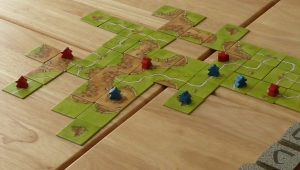 Say the words “game” and “gaming” and most people these days will think about controllers and consoles and periodic downloadable content updates. But it wasn’t all that long ago that the default definition for those words was the good old fashioned boardgame.
Say the words “game” and “gaming” and most people these days will think about controllers and consoles and periodic downloadable content updates. But it wasn’t all that long ago that the default definition for those words was the good old fashioned boardgame.
Coming from a pretty tight-knit family with a passion for mentally stimulating pastimes, I grew up playing a lot of board and tabletop games, but the inevitable “growing up” and the advent of shiny technological distractions drew me away from them (the games, not my family). Then for this past birthday, my wife gave me Carcassonne, one of the recent wave of “Euro-” or “German-style” boardgames that have been hugely successful with hardcore gamers, casual gamers and families alike.
I haven’t picked up my PS3 controller since.
Here’s my review…
In contrast to more traditional boardgames (like Monopoly or Sorry! or The Game of Life) that center around the rolling of dice and the movements of counters, German-style boardgames—so called because this type of game was born in the 1960s and ’70s in Germany, which seems to be the boardgaming capital of the world—focus more on strategy and social interaction than on luck and conflict.
Named for a medieval city in southern France famed for its fortified walls, Carcassonne is one of those games that is simple to learn—my wife’s grandparents, two octogenarians who had never played a Eurogame before, picked it up in less than an hour— but nuanced enough to offer a consistently interesting experience to players of all ages through frequent replays.
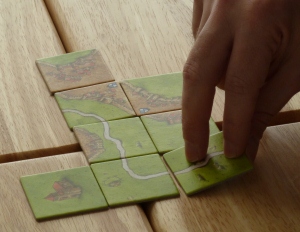
Laying down some road
The gameplay is relatively straightforward. The players take turns randomly drawing tiles that depict bits of landscape and laying them down to cooperatively create a different game board map every time the game is played. The only requirement is that the terrain features of the tile being played match the edges of tiles adjacent to it. My inner jigsaw puzzle enthusiast approves. They must also use a limited supply of person-shaped wooden markers (called “followers” or, colloquially, “meeples”) to claim features of the emerging landscape for points; for instance, a completed road will award one point per tile it traverses for the player claiming it, while completed cities score two points per tile for their claimants.
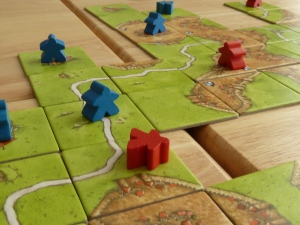
Followers doing what followers do
The challenge lies in resource management. You can pin your hopes on making a city you’ve claimed gargantuan, blowing everybody else out of the water in one fell swoop, but I’ve played more than one game in which the tiles I needed to finish that giant metropolis and reap a windfall of points just never turned up. Likewise, deciding whether to complete a city as soon as possible (potentially giving up a cornucopia of points) to reclaim a meeple or expend him on farmland—where he must remain until game’s end—can be agonizing, especially for one’s fellow players since the rules do not include a time limit on dithering or hemming and hawing.
The basic game is designed for two to five players and takes about 45 to 60 minutes to play out. In the twelve years since its initial release, there have been numerous expansions which add more types of tiles and followers, thus expanding the variety of ways to score points and also—because the game ends when all the available tiles have been played—extending the length of the game. The first of the expansions, 2002’s Inns and Cathedrals, added meeples for a sixth player as well.
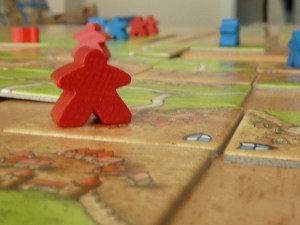
Meeples!
It isn’t only the ease of learning that makes Carcassonne (and other games of its ilk) great for families and casual gamers; there are also the facts that the play is at least partially cooperative, allowing any group to make a game as friendly or cutthroat as they find enjoyable, and that no player is ever eliminated before the end of the game. The various gameplay elements added by the expansions mean that there’s always a way to spice the game up if you want to, and also that it’s customizable to whatever extent maximizes your enjoyment of it.
Carcassonne is the work of one Klaus-Jürgen Wrede—one of the really nice things about German-style boardgames is that the games’ designers are credited and rewarded for their creative efforts—and won several Game of the Year awards the year it was released. It has deservedly been a smash hit here in the States, and has become a popular “gateway game”, a game that introduces folks to the German-style boardgame and thus leads them to others like The Settlers of Catan, Puerto Rico, and Ticket to Ride.
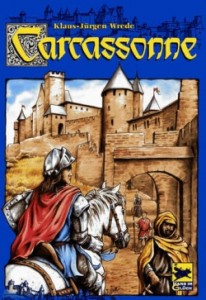 I’ll probably get to those others before too long, but for now they’ll have to wait. I’m having too much fun with Carcassonne. If you’re looking for an interesting way to spend time with friends or loved ones, and need to get away from the modern world’s numerous digital emanations and electronic distractions, I cannot recommend Carcassonne highly enough.
I’ll probably get to those others before too long, but for now they’ll have to wait. I’m having too much fun with Carcassonne. If you’re looking for an interesting way to spend time with friends or loved ones, and need to get away from the modern world’s numerous digital emanations and electronic distractions, I cannot recommend Carcassonne highly enough.